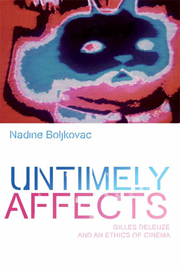2 - Figures of Life
Published online by Cambridge University Press: 05 September 2013
Summary
The artist is a seer, a becomer.
(WIP: 171)War nods off to sleep, but keeps one eye always open.
(NB)Consciousness is only a dream with one's eyes open.
(SPP: 20)First sight of the camp: it is another planet.
(NB)‘NACHT, “nuit”, disaient-ils, c'est l'oubli. NEBEL, “brouillard”, c'est la fumée dans laquelle vous vous volatiserez tous – ihr werdet krepieren, “vous crèverez tous!”’ (Raskin 1987: 16). Against ‘night’ and ‘fog’, against the threat of forgetting humanity's capacity for mass extermination and dehumanisation, Resnais' 1955 Nuit et Brouillard forges. In search of life through the imperceptible, impossible sight of ‘another planet’ bent on shame and annihilation, Nuit et Brouillard confronts actual and virtual remains of the Holocaust as the film's audio-visual assemblages of relentless, painstaking movements, plaintive score and dispassionate voiceover profoundly violate our sight and means for sensory release from the affective violence, the ‘endless, uninterrupted fear …’ (NB). If, as Deleuze contends, ‘Resnais succeeds in showing, by means of things and victims, not only the functioning of the camp but also the mental functions, which are cold, diabolical, almost impossible to understand which preside over its organization’ (C2: 121), Nuit et Brouillard also undercuts these efficient murderous operations through piercing revelations of horrors that at once resist and disavow their very exposure: ‘no description, no image can reveal their true dimension’ (NB).
- Type
- Chapter
- Information
- Untimely AffectsGilles Deleuze and an Ethics of Cinema, pp. 31 - 60Publisher: Edinburgh University PressPrint publication year: 2013



